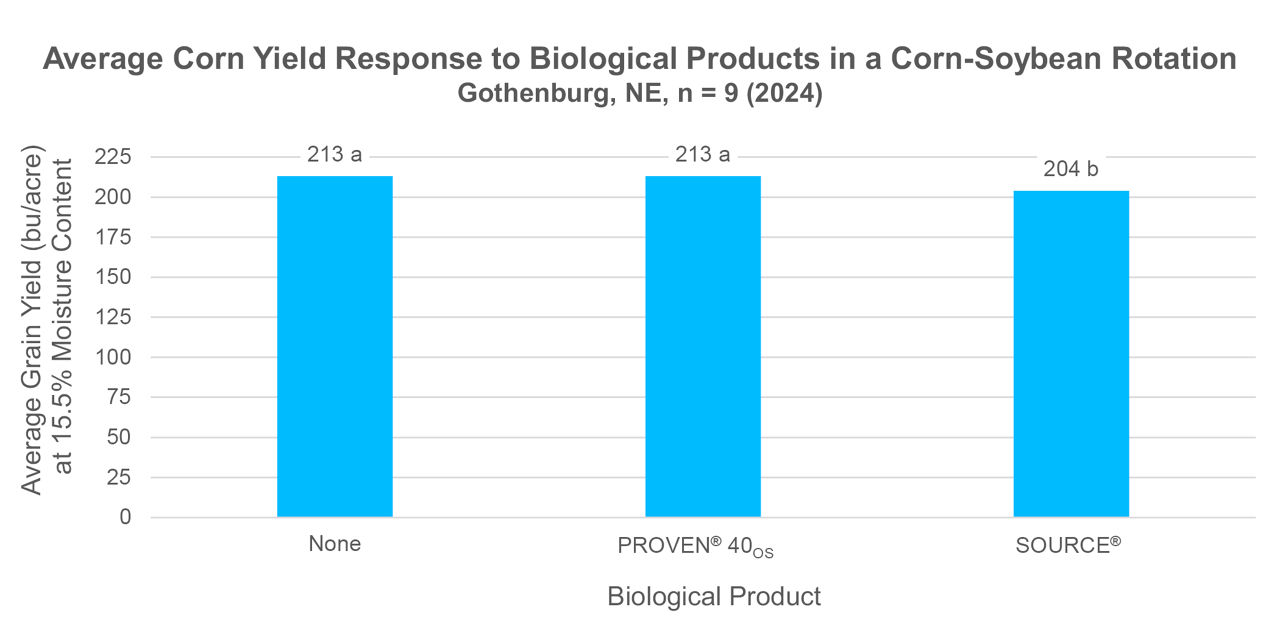Understanding the Role of Biological Products in Corn Nitrogen Fertilization
February 6, 2025
Click on a tab below to see data collected each year for this study
TRIAL OBJECTIVE
- Biological products may offer environmentally friendly and sustainable solutions to enhance crop productivity, improve soil health, and manage pests and diseases. These products include beneficial bacteria, plant extracts, beneficial viruses, and other compounds.
- The objective of this trial was to test emerging biological products that enhance nitrogen (N) uptake by corn plants, decreasing synthetic nitrogen fertilizer needs.
RESEARCH SITE DETAILS

- The trial was arranged as a randomized complete block design including three replications with three treatment factors described below (Figure 1):
- Crop rotation: corn-corn or corn-soybean
- Nitrogen rates: 0, 100, or 200 lb/acre
- Corn-on-corn rotation nitrogen strips have been in the same location for the 2023 and 2024 growing season, so the strips have grown corn and had the same amount of N applied for several years.
- Biological nitrogen products: no product, Pivot Bio biological product PROVEN® 40os (biological fertilizer seed treatment), Sound Agriculture biological product SOURCE® (soil activator)

- For the statistical analysis, the study was split according to the crop rotation: corn-corn, and corn-soybean.
- Soil was conventionally tilled with no base fertilizer application.
- Nitrogen was the only fertilizer added to the plots.
- 214-22STXRIB brand corn was planted on May 15, 2024, at a rate of 34,000 plants/acre into 190 ft by 10 ft strips.
- PROVEN® 40os seed treatment was applied to seed according to the manufacturer's recommendation.
- On June 19, 2024, corn POST herbicides were applied: Roundup PowerMAX® herbicide (32 oz/acre), Warrant® herbicide (48 oz/acre), Laudis® herbicide (3 oz/acre), and Diflexx® herbicide (8 oz/acre).
- Nitrogen fertilization was applied with Y-drop equipment at the treatment rates described above on June 18, 2024, at approximately the V5 corn growth stage.
- SOURCE® soil activator was sprayed at 0.7 fl oz per acre in a 10 gal water mix when the crop reached the V12 corn growth stage.
- The total rainfall accumulated during the 2024 corn growing season was 11.88 inches. This trial was implemented in a linear irrigation system, and the total irrigation applied was 5 inches.
- Total weight, test weight, and moisture content were collected with a plot combine on October 18, 2024, and yield per acre was later calculated.

UNDERSTANDING THE RESULTS
Corn Grain Yield in a Corn-Corn Rotation

- Corn grain yield was responsive to nitrogen rates in the corn-corn rotation. Corn to which 200 lb N/acre was applied produced a significantly higher yield than corn that received either of the other two nitrogen treatments. The average yield for the 200 lb N/acre treatment was 128% larger than the 0 lb N/acre treatment, and 6% larger than the 100 lb N/acre treatment.

- In the corn-corn rotation, corn given the PROVEN® 40os seed treatment produced a greater average yield than corn given the SOURCE® soil activator. However, the average yield of the corn given the PROVEN® 40os seed treatment was similar to the average yield of corn given no biological product application.
Corn Grain Yield in a Corn-Soybean Rotation

- Corn grain yield was also responsive to nitrogen rates in the corn-soybean rotation. The highest average yield occurred in corn to which 100 lb N/acre was applied. The average yield for the 100 lb N/acre treatment was 3% larger than the 200 lb N/acre treatment, and 14% larger than the 0 lb N/acre treatment.

- In the corn-soybean rotation, corn with PROVEN® 40os seed treatment and the treatment without any biological product application (none, on the graph) produced a 4% greater average yield than corn with SOURCE® soil activator.

KEY LEARNINGS
- Corn grain yield was responsive to nitrogen rates, especially under corn-corn rotation.
- PROVEN® 40os seed treatment and SOURCE® soil activator were not effective in increasing corn grain yield compared to the treatment without biological products.
- PROVEN® 40os seed treatment and the treatment without a biological product produced similar average yields, both of which were higher than the average yield in the SOURCE® soil activator treatments.
- Live biological products such as PROVEN® 40os seed treatment and products that act on biological systems such as SOURCE® soil activator may respond to specific weather, management, and environmental conditions.
1213_383954